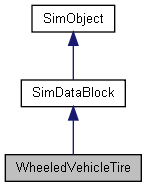
|
|
|
WheeledVehicleTire Class Reference
[Vehicles]
Defines the properties of a WheeledVehicle tire. More...

Public Attributes | |
| float | kineticFriction |
| Tire friction when the wheel is slipping (no traction). | |
| float | lateralDamping |
| Damping force applied against lateral forces generated by the tire. | |
| float | lateralForce |
| Tire force perpendicular to the direction of movement. | |
| float | lateralRelaxation |
| Relaxing force applied against lateral forces generated by the tire. | |
| float | longitudinalDamping |
| Damping force applied against longitudinal forces generated by the tire. | |
| float | longitudinalForce |
| Tire force in the direction of movement. | |
| float | longitudinalRelaxation |
| Relaxing force applied against longitudinal forces generated by the tire. | |
| float | mass |
| The mass of the wheel. | |
| float | radius |
| The radius of the wheel. | |
| float | restitution |
| Tire restitution. | |
| filename | shapeFile |
| The path to the shape to use for the wheel. | |
| float | staticFriction |
| Tire friction when the wheel is not slipping (has traction). | |
Detailed Description
Defines the properties of a WheeledVehicle tire.
Tires act as springs and generate lateral and longitudinal forces to move the vehicle. These distortion/spring forces are what convert wheel angular velocity into forces that act on the rigid body.
Member Data Documentation
Tire friction when the wheel is slipping (no traction).
Damping force applied against lateral forces generated by the tire.
- See also:
- lateralForce
Tire force perpendicular to the direction of movement.
Lateral force can in simple terms be considered left/right steering force. WheeledVehicles are acted upon by forces generated by their tires and the lateralForce measures the magnitude of the force exerted on the vehicle when the tires are deformed along the x-axis. With real wheeled vehicles, tires are constantly being deformed and it is the interplay of deformation forces which determines how a vehicle moves. In Torque's simulation of vehicle physics, tire deformation obviously can't be handled with absolute realism, but the interplay of a vehicle's velocity, its engine's torque and braking forces, and its wheels' friction, lateral deformation, lateralDamping, lateralRelaxation, longitudinal deformation, longitudinalDamping, and longitudinalRelaxation forces, along with its wheels' angular velocity are combined to create a robust real-time physical simulation.
For this field, the larger the value supplied for the lateralForce, the larger the effect steering maneuvers can have. In Torque tire forces are applied at a vehicle's wheel hubs.
Relaxing force applied against lateral forces generated by the tire.
The lateralRelaxation force measures how strongly the tire effectively un-deforms.
- See also:
- lateralForce
Damping force applied against longitudinal forces generated by the tire.
- See also:
- longitudinalForce
Tire force in the direction of movement.
Longitudinal force can in simple terms be considered forward/backward movement force. WheeledVehicles are acted upon by forces generated by their tires and the longitudinalForce measures the magnitude of the force exerted on the vehicle when the tires are deformed along the y-axis.
For this field, the larger the value, the larger the effect acceleration/deceleration inputs have.
- See also:
- lateralForce
Relaxing force applied against longitudinal forces generated by the tire.
The longitudinalRelaxation force measures how strongly the tire effectively un-deforms.
- See also:
- longitudinalForce
| float WheeledVehicleTire::mass |
The mass of the wheel.
Currently unused.
The radius of the wheel.
The radius is determined from the bounding box of the shape provided in the shapefile field, and does not need to be specified in script. The tire should be built with its hub axis along the object's Y-axis.
Tire restitution.
Currently unused.
| filename WheeledVehicleTire::shapeFile |
The path to the shape to use for the wheel.
Tire friction when the wheel is not slipping (has traction).